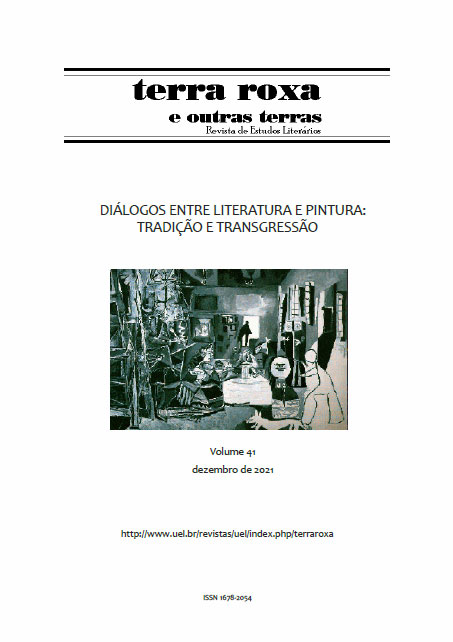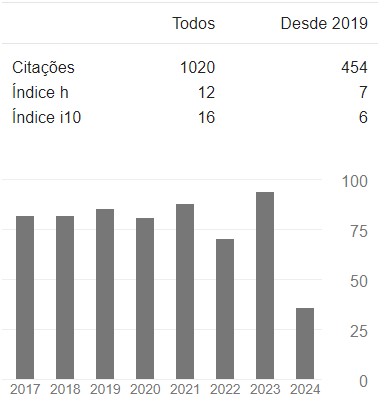Images of blindness: intermedial references to paintings in "Blindness"
DOI:
https://doi.org/10.5433/1678-2054.2021v41p58Keywords:
Literature, Painting, Intermedial references.Abstract
This paper presents an analysis of the dialogue between literature and painting in José Saramago’s Blindness (1995/1997). It deals with two moments in the novel in which there are references to famous paintings: the first one is mentioned by the anonymous narrator, who associates the status quo of the blind people in the city to a painting; the second one, by the anonymous character’s descriptions who mentions the last paintings he saw in a museum before becoming blind. These descriptions intensify the desperate state in which the characters live, just as the narrator’s description reaffirms the impossibility of blind people leading other people. The asylum is the place where all the blind people are taken, until the moment when, apparently, there is no one who can see, except for the doctor’s wife. To explore the types of dialogue between literature and painting, we will present concepts such as ekphrasis, evocation, allusion, pictorial description, conceived by Liliane Louvel, Claus Clüver, Irina Rajewsky, and Werner Wolf.
Downloads
References
CLÜVER, Claus. A New Look at an Old Topic: Ekphrasis Revisited. Todas as Letras, São Paulo, v. 19, n. 1, p. 30-44, jan./abr. 2017.
CUNHA, Sonia. A última ceia de Leonardo da Vinci. Disponível em: https://www.culturagenial.com/a-ultima-ceia/. Acesso em: 07 maio 2021.
LOUVEL, Liliane. Nuanças do pictural. Thaïs Flores Nogueira Diniz, org. Intermidialidade e Estudos interartes: desafios da arte contemporânea. Trad. Márcia Arbex. Belo Horizonte: Editora UFMG, 2012. 47-69.
MOISÉS, Massaud. Dicionário de termos literários. 12. ed. São Paulo: Cultrix, 2004.
MOSER, Walter. As relações entre as artes: por uma arqueologia da intermidialidade. Aletria: Revista de Estudos de Literatura, Belo Horizonte, v. 6, p. 42-65, 1998-1999, .
NOVAES, Adauto. De olhos vendados. Adauto Novaes, org. O olhar. São Paulo: Cia. das Letras, 1977. 9-20.
RAJEWSKY, I. Intermidialidade, intertextualidade e “remediação”. Tradução de Thaïs Flores Nogueira Diniz e Eliana Lourenço de Lima Reis. Thaïs Flores Nogueira Diniz, org. Intermidialidade e estudos interartes: desafios da arte contemporânea. Belo Horizonte, Editora UFMG, 2012. 15-45.
REICHMANN, Brunilda, & Camila Meneghini. Fernando Meirelles: a recriação fílmica de Ensaio sobre a cegueira. Ipotesi, Juiz de Fora, v. 13, n. 1, p. 169-175, jan./jul. 2009.
WOLF, Werner. Intermediality Revisited: Reflections on Word and Music Relations in the Context of a General Typology of Intermediality. Suzanne M. Lodato, Suzanne Aspden, & Walter Bernhart, eds. World and Music Studies: Essays in Honor of Steven Paul Scher and on Cultural Identity and the Musical Stage. Word and Music Studies 4. Leiden: Brill, 2002. 13-34.
Downloads
Published
How to Cite
Issue
Section
License
Copyright (c) 2022 Terra Roxa e outras Terras

This work is licensed under a Creative Commons Attribution 4.0 International License.
Authors who publish in this journal agree to the following terms:
a) The authors retain the copyright and grant the journal the right of first publication, the work being simultaneously licensed under the Creative Commons Attribution-NonCommercial 4.0 International License, allowing the sharing of the work with acknowledgment of the authorship of the work and initial publication in this journal.
b) Authors are authorized to assume additional contracts separately, for non-exclusive distribution of the version of the work published in this journal (eg, publish in an institutional repository or as a book chapter), with acknowledgment of authorship and initial publication in this journal.
c) Authors are allowed and encouraged to publish and distribute their work online (e.g. in institutional repositories or on their personal page) after the editorial process, as this can generate productive changes as well as increase impact and citation of the published work (See The Effect of Open Access).
d) The authors of the approved works authorize the journal to, after publication, transfer their content for reproduction in content indexers, virtual libraries and the like.
e) The authors assume that the texts submitted for publication are of their original creation, taking full responsibility for their content in case of any objection by third parties.



















